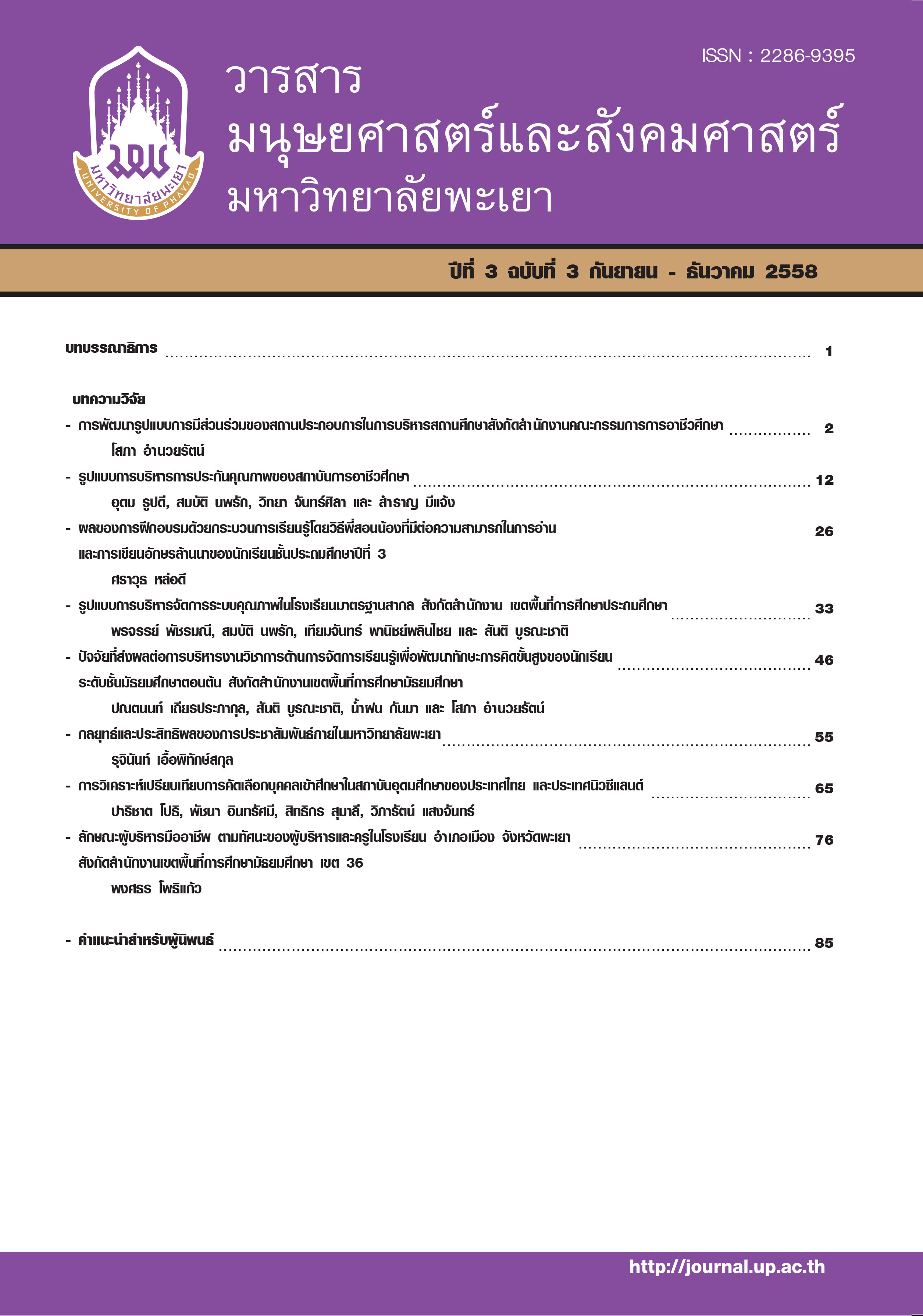รูปแบบการบริหารการประกันคุณภาพของสถาบันการอาชีวศึกษา
คำสำคัญ:
รูปแบบ, การประกัน, สถาบันการอาชีวศึกษาบทคัดย่อ
การวิจัยนี้มีวัตถุประสงค์เพื่อสร้างรูปแบบการบริหารการประกันคุณภาพของสถาบันการอาชีวศึกษา และมีวัตถุประสงค์เฉพาะ ดังนี้ 1) เพื่อศึกษาสภาพและแนวทางการบริหารการประกันคุณภาพของสถาบันการอาชีวศึกษา 2) เพื่อสร้างรูปแบบการบริหารการประกันคุณภาพของสถาบันการอาชีวศึกษา 3) เพื่อประเมินรูปแบบการบริหารการประกันคุณภาพของสถาบันการอาชีวศึกษา วิธีดำเนินการวิจัยมี 3 ขั้นตอน คือ 1) การศึกษาสภาพและแนวทางการบริหารการประกันคุณภาพของสถาบันการอาชีวศึกษา โดยการวิเคราะห์และสังเคราะห์เอกสารและงานวิจัยที่เกี่ยวข้อง ศึกษาสภาพและแนวทางการบริหารการประกันคุณภาพของสถานศึกษาสังกัดสำนักงานคณะกรรมการการอาชีวศึกษาที่มีวิธีปฏิบัติที่ดี (Best Practice) จำนวน 3 แห่ง โดยการศึกษาเอกสารและสัมภาษณ์ และศึกษาแนวทางการบริหารการประกันคุณภาพของสถานศึกษาสังกัดสำนักงานคณะกรรมการการอุดมศึกษาที่รับนักศึกษาต่อเนื่องจากสำนักงานคณะกรรมการการอาชีวศึกษา โดยการสัมภาษณ์ผู้ทรงคุณวุฒิ จำนวน 4 คน 2) การสร้างรูปแบบการบริหารการประกันคุณภาพของสถาบันการอาชีวศึกษา โดยการนำข้อมูลจากขั้นตอนที่ 1 มายกร่างรูปแบบการบริหารการประกันคุณภาพของสถาบันการอาชีวศึกษา และตรวจสอบความเหมาะสมของร่างรูปแบบ ด้วยการสนทนากลุ่มผู้ทรงคุณวุฒิ จำนวน 9 คน สรุปข้อมูลโดยการพิจารณาฉันทามติจากการสนทนากลุ่ม และตรวจสอบความถูกต้อง ความสอดคล้องของร่างรูปแบบ และเครื่องมือประเมินรูปแบบ โดยผู้เชี่ยวชาญ จำนวน 12 คน วิเคราะห์ข้อมูลด้วยการวิเคราะห์เนื้อหาและค่าดัชนีความสอดคล้อง (IOC) 3) การประเมินรูปแบบการบริหารการประกันคุณภาพของสถาบัน โดยการสอบถามความคิดเห็นจากผู้อำนวยการสถาบันการอาชีวศึกษา จำนวน 18 คน ผู้อำนวยการสถานศึกษาสังกัดสถาบันการอาชีวศึกษา ทั้ง 19 สถาบัน จำนวน 160 คน และหัวหน้างานประกันคุณภาพและมาตรฐานการศึกษาของสถานศึกษาสังกัดสถาบันการอาชีวศึกษา ทั้ง 19 สถาบัน จำนวน 161 คน สถิติที่ใช้วิเคราะห์ข้อมูลคือ ค่าเฉลี่ยและส่วนเบี่ยงเบนมาตรฐาน
สรุปผลการวิจัย
- การบริหารการประกันคุณภาพของสถาบันการอาชีวศึกษา ประกอบด้วย 3 องค์ประกอบได้แก่ โครงสร้างคณะกรรมการการประกันคุณภาพของสถาบันการอาชีวศึกษา ขอบข่ายการประกันคุณภาพการศึกษาของสถาบันการอาชีวศึกษา และกระบวนการบริหารการประกันคุณภาพของสถาบันการอาชีวศึกษา
- รูปแบบการบริหารการประกันคุณภาพของสถาบัน ที่สร้างขึ้นเป็นรูปแบบเชิงสัมพันธ์ (Schematic Model) มี 3 องค์ประกอบ 2 เงื่อนไขความสำเร็จ ได้แก่ 1) โครงสร้างคณะกรรมการการประกันคุณภาพของสถาบันการอาชีวศึกษา ประกอบด้วย คณะกรรมการบริหารการประกันคุณภาพของสถาบันการอาชีวศึกษา และคณะกรรมการดำเนินงานการประกันคุณภาพของสถาบันการอาชีวศึกษา แบ่งออกเป็นคณะกรรมการดำเนินงานการประกันคุณภาพระดับสถาบันการอาชีวศึกษากับคณะกรรมการดำเนินงานการประกันคุณภาพระดับสถานศึกษาสังกัดสถาบันการอาชีวศึกษา 2) ขอบข่ายงานประกันคุณภาพการศึกษาของสถาบันการอาชีวศึกษา ประกอบด้วย ขอบข่ายงานในสำนักประกันคุณภาพของสถาบันการอาชีวศึกษา กับขอบข่ายงานประกันคุณภาพของสถานศึกษาสังกัดสถาบันการอาชีวศึกษา 3) กระบวนการบริหารการประกันคุณภาพของสถาบันการอาชีวศึกษา ประกอบด้วยกระบวนการบริหารคุณภาพ PDCA คือ การวางแผน (Plan : P) การดำเนินงาน (Do : D) การตรวจติดตาม (Check : C) การปรับปรุงแก้ไข (Act : A) และ 2 เงื่อนไขความสำเร็จคือ การประสานงาน (Coordinate : Co) และมาตรฐาน (Standard : S)
- ผลการประเมินรูปแบบการบริหารการประกันคุณภาพของสถาบันการอาชีวศึกษา มีความเป็นไปได้อยู่ในระดับมากและความเป็นประโยชน์อยู่ในระดับมาก
References
สำนักงานเลขาธิการสภาการศึกษา. ข้อเสนอการปฏิรูปการศึกษาในทศวรรษที่สอง (พ.ศ. 2552-2561). กรุงเทพฯ; สำนักนโยบายและแผนการศึกษา สำนักงานเลขาธิการสภาการศึกษา. 2552.หน้า 17.
วิทยา ใจวิถี. เอกสารแนวทางการนิเทศการประกันคุณภาพภายในสถานศึกษา: สำนักงานคณะกรรมการการอาชีวศึกษา กระทรวงศึกษาธิการ; 2553. หน้า 35.
วิทยากร เชียงกูล. รายงานสภาวะการศึกษาไทยปี 2555/2556 “บทบาทการศึกษากับการพัฒนาทางเศรษฐกิจและสังคม”: ศูนย์สารสนเทศทางการศึกษา, สำนักงานเลขาธิการสภาการศึกษา; 2556. หน้า 63.
สำนักมาตรฐานการอาชีวศึกษาและมาตรฐานวิชาชีพ. คู่มือการประกันภายในสถานศึกษาอาชีวศึกษา. กรุงเทพฯ: แผนกวิชาการพิมพ์ วิทยาลัยเทคนิคมีนบุรี; 2555. หน้า 11.
สำนักมาตรฐานและประเมินผลอุดมศึกษา. คู่มือประกันคุณภาพการศึกษาภายในระดับอุดมศึกษา. กรุงเทพฯ: สำนักงานคณะกรรมการการอุดมศึกษา; 2553. หน้า 17.
อุไรวรรณ จันทมูล. การปฏิบัติตามขั้นตอนการประกันคุณภาพภายในของสถานศึกษา สังกัดกรมอาชีวศึกษา จังหวัดมหาสารคาม. รายงานการศึกษาค้นคว้าอิสระศึกษาศาสตร์มหาบัณฑิต สาขาวิชาเทคโนโลยีการศึกษา บัณฑิตวิทยาลัย มหาวิทยาลัยมหาสารคาม; 2545.
นักศึกษาปริญญาเอก สาขาวิจัยและพัฒนาหลักสูตร รุ่น DRD 48 หนังสือประกอบการสัมมนาในเทศกาลการศึกษาไทย – อังกฤษ 2549: สถาบันเทคโนโลยีพระจอมเกล้าพระนครเหนือ; 2549. หน้า 69.
สุวิมล ว่องวานิช. การวิเคราะห์และพัฒนาระบบการประเมินผลภายในของสถานศึกษา. กรุงเทพฯ : บริษัทพิมพ์ดี; 2543.
จันทรานี สงวนนาม. ทฤษฏีและแนวปฏิบัติในการบริหารสถานศึกษา. กรุงเทพฯ. บุ๊คพอยท์; 2551. หน้า 93.
รัตนาภรณ์ ศรีพยัคฆ์. เทคนิคการประสานงาน. สถาบันดำรงราชานุภาพ; 2553. หน้า 8-12.
รุ่งนภา จิตรโรจนรักษ์. การพัฒนารูปแบบการบริหารของคณะกรรมการบริหารสถานศึกษาขั้นพื้นฐาน. วิทยานิพนธ์ครุศาสตร์ดุษฎีบัณฑิต สาขาวิชาบริหารการศึกษา บัณฑิตวิทยาลัย จุฬาลงกรณ์มหาวิทยาลัย; 2548. หน้า 19.
ชนม์ชกรณ์ วรอินทร์. การพัฒนารูปแบบการประกันคุณภาพภายในสถานศึกษาระดับการศึกษาขั้นพื้นฐาน : การประเมินแบบเสริมพลัง. ปริญญานิพนธ์การศึกษาดุษฎีบัณฑิต สาขาวิชาการทดสอบและวัดผลการศึกษา บัณฑิตวิทยาลัย มหาวิทยาลัยศรีนครินทรวิโรฒ ประสานมิตร; 2549. หน้า 236.
Keeves, P.J. Educational research. (Methodology and measurement : An international handbook). Oxford: Pergamon Press; 1988. P.559.
Eisner, E. “Education connoisseiship and criticism : Their form and function in education evaluation”. Journal of Aesthetic Education; 1976. p.123-145.
Madaus, G.F., Scriven, M.S. and Stufflebeam, D.I. Evaluation Model. (Viewpoints on Education and Human Service Evaluation). Boston: Kluwer – Nijhoff Publisher; 1983. P.399-402.
Downloads
เผยแพร่แล้ว
How to Cite
ฉบับ
บท
License
ผู้นิพนธ์ต้องรับผิดชอบข้อความในบทนิพนธ์ของตน มหาวิทยาลัยพะเยาไม่จำเป็นต้องเห็นด้วยกับบทความที่ตีพิมพ์เสมอไป ผู้สนใจสามารถคัดลอก และนำไปใช้ได้ แต่จะต้องขออนุมัติเจ้าของ และได้รับการอนุมัติเป็นลายลักษณ์อักษรก่อน พร้อมกับมีการอ้างอิงและกล่าวคำขอบคุณให้ถูกต้องด้วย
The authors are themselves responsible for their contents. Signed articles may not always reflect the opinion of University of Phayao. The articles can be reproduced and reprinted, provided that permission is given by the authors and acknowledgement must be given.







